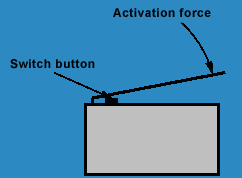


- Joystick actuators -
The Super's round actuator and levers allows for a very fluid motion when moving the joystick in a circular motion.
The square actuator on the Competition and Ultimate don't allow for quite as smooth circular motion, but the diagonal directions are more discreet and easier to "find". I mentioned above that the square actuator "floats". What I mean here is that the actuator is free to rotate on the shaft until it hits the microswitches. This keeps the joysticks from having a blocky feel when moving across the diagonals.

Super Joystick

Competition Joystick
- Spring return-to-center -
I measured the spring rate of each of the springs. First I measured the free length of the spring, and then I applied a known weight to each of the springs and checked the amount of deflection. The spring rate is calculated by dividing the force (weight) by deflection, and is typically given in lbs/inch. A higher spring rate indicates a stiffer spring. Below are my measured spring rates for each of the joysticks.
| Joystick | Free length | Spring rate |
| Super | 1.375" | 8 lbs/in |
| Competiton | 1.438" | 6.4 lbs/in |
| Ultimate | 1.438" | 4.9 lbs/in |
I was surprised by the results of the Ultimate because according to Happ's website, they use the same spring as the Competition. I am speculating that either the information on Happ's website is incorrect, or both of the springs are within Happ's acceptable tolerances.
- Joystick shafts -
| Joystick | Height (Happ's) | Height (measured) |
| Super (short spacer) | n/a | 3.19" |
| Super (long spacer) | 3.41" | 3.44" |
| Competition | 3.66" | 3.40" |
| Ultimate | 3.66" | 3.66" |
Here I find that the Competition is actually about 1/4" shorter than listed on Happ's website. The taller the joystick, the less effort that is required to move the joystick as you have a longer moment arm.
The knob diameter on the Super is slightly larger at 1.30" versus the 1.25" diameter found on both the Competition and Ultimate. If you have larger hands, you will find that you can grip the Super a bit better.
Both the Competition and Super joystick use a 10mm diameter steel shaft and the Ultimate uses a slightly smaller 5/16" (8mm) shaft. I can't see the reason for using a lighter-duty shaft on the joystick with the longest moment arm. That is just the opposite of how you would think it should be designed. Based on this alone, I would say that the Ultimate is the lightest duty stick of the group, but read on...
Copyright © 2002 Oscar
Controls. All Rights Reserved.
http://mirrors.arcadecontrols.com/OscarControls
Oscar Controls is not affiliated with any company
mentioned herein unless explicitly stated otherwise.